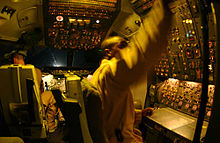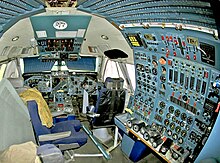Flight engineer


A flight engineer (also known as a flight engineer or second officer) is a cockpit member and belongs to the minimum crew of older, large commercial aircraft with a three-person cockpit . In addition to the captain ( commander ) and the co-pilot (also called first officer), he is the third crew member in the cockpit. In Germany, an independent two and a half year training course, which requires at least a degree from a technical college , leads to a flight engineering license.
The flight engineer is responsible for monitoring and operating the aircraft systems such as the pressurized cabin, the fuel supply and the engines. In the event of an error, he will remedy the situation. He reads checklists and carries out technical checks on the aircraft on the ground and in the air. Since the 1980s, due to the progressive automation of the cockpits , the tasks of flight engineer have largely been performed by the pilots.
history
At the beginning of aviation, in addition to the pilots, other personnel were necessary to operate large and complex aircraft. In the early years of aviation, long-haul flights had a radio operator on board who was responsible for communication. This was soon possible for the pilots themselves through improved and simplified radio equipment. Until the mid-1960s , the navigator had taken great effort to determine the position of the aircraft over the oceans, but over time navigation systems such as inertial navigation system (INS) and flight management system (FMS) took over. The technical progress in the cockpit led to constant improvements in the support of the pilots, but initially not to the elimination of the flight engineer. In 1981 in the Boeing 767 , in 1982 with the Airbus A310 and in 1987 with the introduction of the Airbus A320 , the computer found its way into the cockpit. The routine work in normal operation has been significantly reduced, but the complexity has increased. It was not long before the large commercial aircraft such as the Boeing 747 and Airbus A340 were also equipped with these technologies. Systems such as EICAS provided the pilot with information about the various aircraft systems, so that from now on the two pilots could take on the tasks of flight engineers.
Today flight engineers are only used in the operation of older aircraft types or special aircraft such as heavy transporters. No flight engineers, but on-board technicians or flight technicians entrusted with similar tasks are still employed in military aviation , the police and air rescue .
Flight engineer license
Training and licensing is regulated by the International Civil Aviation Organization (ICAO) in the appendix to the Convention of the International Civil Aviation Organization. In order to be able to work as a flight engineer, the following conditions must be met:
- At least 18 years old
- Medical certificate
Knowledge:
- Air law
-
Aeronautical engineering
- Basic principles of propulsion systems in aircraft
- Operation of aviation engines
- Aircraft fuselage , structure , tail , landing gear , corrosion, and fatigue
- Ice and rain protection
- Pressurized cabin , air conditioning and air supply
- Hydraulic and pneumatic systems in aircraft
- Electrical systems in aircraft
- Flight instruments and avionics
- Aircraft restrictions
- Fire extinguishing systems
- Review and use of equipment and systems in aircraft, flight conditions and loading
- Weight and Balance
- Evaluation of data during the flight
- Determination of damage and defects
- human capacity
- meteorology
- Operational procedures
- General aircraft knowledge
- Basics of aircraft maintenance , fault reports and preflight checks
- Flight procedures, normal and emergency procedures
- Procedure for freight and dangerous goods
- Basics of flying
- aerodynamics
- Communication and radiotelephony
The flight engineer should conduct the first 100 hours of flight as a flight engineer under the supervision of a person who has been trained for this task.
Germany
The training of flight engineers is implemented nationally in § 3 LuftPersV . Reference is made to the announcement of the provisions on the licensing of flight engineers (JAR-FCL 4) .
Requirement:
- Class I medical certificate
- Knowledge of aeronautical engineering at university level or license for authorized personnel for aircraft classes B1, B2 or C
Education:
- Theoretical course for flight engineers
- Proof of knowledge of the English language or AZF radiotelephone certificate
- Training in aircraft maintenance with 100 hours of theory and 30 days of internship
- Aviation instruction
- Flight crew cooperation training course
- Type ratings on a two-pilot aircraft with a minimum flight crew of a flight engineer
The flight engineer license is issued for five years. The flight engineer’s rights are restricted until he has demonstrated 100 hours of flight experience under the direct supervision of a flight engineer instructor. Flight engineers have to keep a flight log as proof of their activity.
The number of flight engineer licenses valid in Germany decreased from 1,100 to 10 between 1991 and 2019.
Exercise of rights
A flight engineer may only be active in the transport of passengers if he was active on a flight as a flight engineer on an aircraft or flight simulator of the same type within the previous 90 days. The type ratings are valid for one year. For the extension you need:
- Ten flights as a flight engineer on the aircraft type. These can be replaced by a flight with an examiner
- Proficiency check
Additional training
- Instructor license for flight engineers TRI (E)
- Flight Engineer Examiner TRE (E)
Commercial aircraft of the last 50 years with a 3-person cockpit
- Aérospatiale-BAC Concorde
- Airbus : A300 up to and including series B4-200, not types B4-200-203FF and 220FF
- Boeing : 707 (initially 4-man with navigator for overwater flights, at Lufthansa: with 2 navigators for pole flights), 727 , 747 series -100 to -300
- Convair CV-880 , Convair CV-990
- Dassault Mercure
- Hawker Siddeley Trident
- Lockheed L-188 Electra
- Lockheed L-1011 TriStar
- McDonnell Douglas : DC-8 , DC-10 (not MD-10)
- Shanghai Y-10
- Sud Aviation Caravelle
- Vickers VC10
- almost all machines from the Soviet Union; here sometimes even 4- (navigator) or 5-man (plus radio operator), including the Tupolev Tu-144
Web links
- Flight engineer Federal Employment Agency Retrieved January 22, 2013
Individual evidence
- ^ Rudolf Braunburg: The third man air traffic between romance and routine. Zeit-Online, November 23, 1979, accessed September 14, 2019 .
- ↑ a b Appendices to the Convention of the International Civil Aviation Organization (ICAO), Appendix 1: Personnel Licensing.
- ↑ a b Federal Gazette: Announcement of the provisions on the licensing of flight engineers (JAR-FCL 4 German). Federal Ministry of Justice, April 15, 2003, accessed on September 8, 2019 .
- ↑ Luftfahrtbundesamt ( Federal Aviation Office): Licenses available at the LBA for pilots by license type. March 1, 2019, accessed January 30, 2020 .
